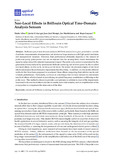Mostrar el registro sencillo del ítem
Non-local effects in Brillouin optical time-domain analysis sensors
| dc.creator | Iribas Pardo, Haritz | es_ES |
| dc.creator | Urricelqui Polvorinos, Javier | es_ES |
| dc.creator | Mompó Roselló, Juan José | es_ES |
| dc.creator | Mariñelarena Ollacarizqueta, Jon | es_ES |
| dc.creator | Loayssa Lara, Alayn | es_ES |
| dc.date.accessioned | 2017-11-15T09:28:43Z | |
| dc.date.available | 2017-11-15T09:28:43Z | |
| dc.date.issued | 2017 | |
| dc.identifier.issn | 2076-3417 | |
| dc.identifier.uri | https://hdl.handle.net/2454/26184 | |
| dc.description.abstract | Brillouin optical time-domain analysis (BOTDA) sensors have great potential to provide distributed measurements of temperature and strain over large structures with high spatial resolution and measurement precision. However, their performance ultimately depends on the amount of probe and pump pulse power that can be injected into the sensing fiber, which determines the signal-to-noise ratio of the detected measurement signal. The probe wave power is constrained by the generation of noise induced by spontaneous Brillouin scattering and at lower power by the so-called non-local effects. In this work, we focus on the latter. We review the physical origins of non-local effects and analyze the performance impairments that they bring. In addition, we discuss the different methods that have been proposed to counteract these effects comparing their relative merits and ultimate performance. Particularly, we focus on a technique that we have devised to compensate non-local effects which is based on introducing an optical frequency modulation or dithering to the probe wave. This method is shown to provide a comprehensive solution to most of the impairments associated with non-local effects and also to enable some side benefits, such as amplification of the pump pulses to compensate the attenuation of the fiber. | en |
| dc.description.sponsorship | The authors wish to acknowledge the financial support of the Spanish Ministerio de Economía y Competitividad through the projects TEC2013-47264-C2-2-R and TEC2016- 76021-C2-1-R, FEDER funds and the Universidad Pública de Navarra. | en |
| dc.format.extent | 12 p. | |
| dc.format.mimetype | application/pdf | en |
| dc.language.iso | eng | en |
| dc.publisher | MDPI | en |
| dc.relation.ispartof | Applied sciences 2017, 7(8), 761 | en |
| dc.rights | © 2017 by the authors. Licensee MDPI, Basel, Switzerland. This article is an open access article distributed under the terms and conditions of the Creative Commons Attribution (CC BY) license. | en |
| dc.rights.uri | https://creativecommons.org/licenses/by/4.0/ | |
| dc.subject | Stimulated Brillouin scattering | en |
| dc.subject | Brillouin optical time-domain analysis | en |
| dc.subject | Non-local effects | en |
| dc.title | Non-local effects in Brillouin optical time-domain analysis sensors | en |
| dc.type | Artículo / Artikulua | es |
| dc.type | info:eu-repo/semantics/article | en |
| dc.contributor.department | Institute of Smart Cities - ISC | es_ES |
| dc.rights.accessRights | Acceso abierto / Sarbide irekia | es |
| dc.rights.accessRights | info:eu-repo/semantics/openAccess | en |
| dc.identifier.doi | 10.3390/app7080761 | |
| dc.relation.projectID | info:eu-repo/grantAgreement/MINECO//TEC2013-47264-C2-2-R/ES/ | en |
| dc.relation.projectID | info:eu-repo/grantAgreement/ES/1PE/TEC2016-76021 | en |
| dc.relation.publisherversion | https://dx.doi.org/10.3390/app7080761 | |
| dc.type.version | Versión publicada / Argitaratu den bertsioa | es |
| dc.type.version | info:eu-repo/semantics/publishedVersion | en |
| dc.contributor.funder | Universidad Pública de Navarra / Nafarroako Unibertsitate Publikoa | es |



